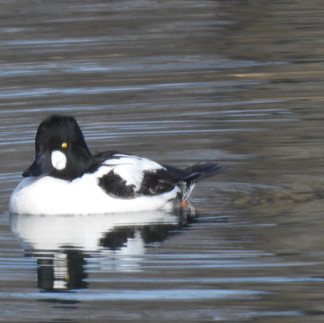007 Duck with the Golden Eye!
- Terry Wise

- Feb 21, 2023
- 2 min read
Over the past week, an avian visitor has frequented the west Carillon Stonegate Pond. Preferred solitude - moved away from Mallards and Canada Geese.
And this duck had an unusual identifier - a bright golden eye! There is a white oval spot on the cheek.
The Common Goldeneye!
Common Goldeneyes have compact, medium-sized bodies with large heads, relatively small and narrow bills, and short tails. Male and female goldeneyes have different patterns and coloring. The adult male has a large dark triangular head and a sloping bill. In good light or the right view, the male’s black head has a greenish sheen. There is a white oval spot on the cheek, between the dark bill and the conspicuously bright yellow eye - i.e., “goldeneye”. The body is mostly white with white segments along the folded wing. The female’s bill is dark with a small amount of yellow near the tip. The head is chestnut brown and more round. The body is gray. Sometimes a white collar is visible around the neck. The female’s eye is pale yellow or white. Their legs are very short and far to the rear of their body, making it difficult for them to stand on land. Three of the toes are webbed to help with swimming.
The Common Goldeneye averages around twenty (20) inches in length. And their wingspan is approximately thirty-one (31) inches. They weigh in at around thirty-three (33) ounces.
Common Goldeneyes are fast-flying ducks that reach speeds of over 40 miles an hour. Their wings make a distinctive whistling sound in flight. Unlike many diving ducks, they only need a short runway to run or “patter” across the water before taking off.
Common Goldeneyes are diving ducks that often forage in flocks. They are strong swimmers and divers that spend much of their time on the water, often in large flocks. Common Goldeneyes dive frequently in search of prey, and often synchronize their dives with others. Underwater they hold their wings tight to their bodies and kick with their feet.
Common Goldeneyes eat mainly aquatic invertebrates such as crustaceans and mollusks, and fish and fish eggs. Vegetation such as seeds and tubers makes up less than a quarter of the diet. They feed mainly along shorelines in relatively shallow water.
Common Goldeneyes are common migrants and winter residents throughout Illinois. They reside across Canada, Alaska, and northern Great Plains during breeding season and much of the northern U.S. during winter. They nest in holes in trees near lakes, rivers, or wetlands. Common Goldeneye chicks must watch that first step when they leave the nest – it’s a doozy. With nests placed in tree cavities up to 40 feet high, that first step is a long way down. As the female stands at the base of the tree and calls, the downy chicks jump from the nest hole one after the other and tumble to the ground.
So when you are out on your winter walk, look out over our ponds and you may see this brilliant black and white duck with the "golden eye".
Take a hike and see what you can find – and identify!



















Comments